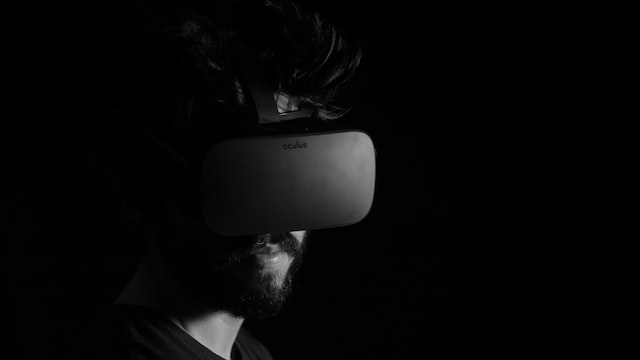Room Scale Virtual Reality (VR) is a technology that allows users to interact with virtual environments in a more natural way. Using room-scale VR, users can move around freely within a designated space, allowing for a more immersive experience. This type of VR is often used for gaming and simulation applications.
Room-scale VR systems typically use either optical or electromagnetic tracking to track the user’s movements. Optical tracking systems use cameras to track the user’s position, while electromagnetic tracking systems use sensors that emit and detect electromagnetic fields. Room-scale VR systems usually have multiple cameras or sensors placed around the room to provide 360-degree coverage.
What is Virtual Reality?
Virtual reality is a computer-generated environment that allows a user to interact with three-dimensional images. It is often used in video games, simulations, and training programs. Virtual reality can create realistic environments that are not possible to experience in the real world.
Virtual reality technology has come a long way since its inception in the early 1950s. Early virtual reality systems used large, expensive computers to generate crude images. Today, virtual reality is created using powerful graphics processors and software that can create realistic environments.
Virtual reality is a simulated experience that can be similar to or completely different from the real world. Applications of virtual reality include entertainment (e.g. video games) and education (e.g. medical or military training). Other distinct types of VR-style technology include augmented reality and mixed reality.
A person using virtual reality equipment is typically able to “look around” the artificial world, move about in it, and interact with virtual features or items. The effect is commonly created by VR headsets consisting of a head-mounted display with one or two small high-resolution OLED or LCD monitors providing separate images for each eye, stereoscopic headphones delivering sound to each ear, and head motion tracking sensors. Some VR systems also include tactile information, generally known as haptic feedback.
Haptic feedback is the sense of touch that can be simulated in virtual reality. This can be used to create the sensation of being able to touch, feel, and manipulate virtual objects. Most VR systems use some form of haptic feedback, which can be as simple as rumble motors in-game controllers or as complex as full-body suits that provide a variety of sensations.
How Room-Scale VR Works
Most room-scale VR systems use either optical or electromagnetic tracking to track the user’s movements. Optical tracking systems use cameras to track the user’s position, while electromagnetic tracking systems use sensors that emit and detect electromagnetic fields. Room-scale VR systems usually have multiple cameras or sensors placed around the room to provide 360-degree coverage.
Room-scale VR systems often use a combination of head-mounted displays (HMDs), controllers, and other peripherals to create a complete virtual reality experience. HMDs are worn by the user and display the virtual environment. Controllers are used to interact with the environment and can take many different forms, such as hand controllers, gloves, or body suits. Other peripherals, such as treadmills or haptic feedback devices, can also be used to enhance the room-scale VR experience.
Benefits of Room-Scale VR
Room-scale VR provides a more immersive experience than other types of VR because it allows users to move around freely within the virtual environment. This gives users a greater sense of presence in the environment and can lead to a more realistic experience. Additionally, room-scale VR can be used for a variety of applications, including gaming, simulation, training, and education.
Room-scale VR can also be used to create social experiences. For example, room-scale VR can be used to host virtual parties or meetups. Additionally, room-scale VR can be used for collaborative work, such as when multiple users need to work on a virtual model or design.
Applications for Room-Scale VR

Room-scale VR can be used for a variety of applications, including gaming, simulation, training, and education.
Gaming is one of the most popular uses for room-scale VR. Room-scale VR provides an immersive gaming experience that can be used for both single-player and multiplayer games. Simulation is another common use for room-scale VR. Simulations can be used for everything from flight training to medical procedures. Training is another common application for room-scale VR. Using room-scale VR, businesses can train employees in a safe and realistic environment. Finally, room-scale VR can also be used for education. For example, room-scale VR can be used to create virtual field trips or to teach students about other cultures and environments.
Room-Scale VR vs Other types of VR
Room-scale VR is the most immersive type of VR because it allows users to move around freely within the virtual environment. This gives users a greater sense of presence in the environment and can lead to a more realistic experience. Additionally, room-scale VR can be used for a variety of applications, including gaming, simulation, training, and education.
Other types of VR, such as seated VR or standing VR, do not allow users to move around freely. Instead, users are confined to a designated space. This can limit the immersion of the VR experience and the types of applications that can be used. Additionally, room-scale VR systems often use a combination of head-mounted displays (HMDs), controllers, and other peripherals to create a complete virtual reality experience. HMDs are worn by the user and display the virtual environment. Controllers are used to interact with the environment and can take many different forms, such as hand controllers, gloves, or body suits. Other peripherals, such as treadmills or haptic feedback devices, can also be used to enhance the room-scale VR experience.
Conclusion
It’s easy to see why room-scale VR is becoming the preferred choice for many virtual reality applications. Room-scale VR provides a more immersive experience than other types of VR because it allows users to move around freely within the virtual environment. Additionally, room-scale VR can be used for a variety of applications, including gaming, simulation, training, and education. If you’re looking for the most immersive VR experience possible, room-scale VR is the way to go.

